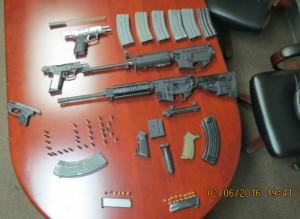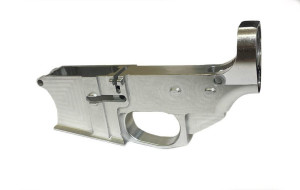Authorities Arrest Man Smuggling Weapons into Mexico, Including Assault Rifle Modified with 3D Printed Part

Weapons seized from an Arizona man earlier this month included a partially 3D printed assault rifle. [Image: Customs and Border Protection]
Fully 3D printable guns aren’t the only concern, however – the technology can also be used to modify existing weapons to make them more dangerous. Earlier this month, US Customs and Border Protection officers arrested Julian Higuera, a US citizen from Phoenix, just before he crossed into Mexico with a truck full of guns and ammunition. One of those guns, the officers discovered, was a semi-automatic assault rifle modified to function as a fully automatic.
Higuera had swapped the lower receiver of the gun for a plastic, 3D printed part that allowed the weapon to fire fully automatically, spraying bullets for as long as the trigger is held down. It’s illegal in the US to modify a weapon into a full automatic, but there’s no shortage of technology that makes it easy for anyone to do just that – including Wilson’s Ghost Gunner, a CNC mill capable of printing the lower receiver of an AR-15, the type of semi-automatic that Higuera had modified. While Higuera’s 3D printed receiver was made from plastic, the Ghost Gunner manufactures parts in metal, and not only makes it easy to modify a weapon, but also to make it untraceable.
Therein lies a major part of the controversy surrounding Wilson and his fellow proponents of 3D printed weaponry. Not only is it easy for anyone to print their own guns, but it’s easy to make them completely untraceable, which holds obvious appeal for smugglers such as Higuera. While Wilson insists that his release of his open-source 3D printable gun files online is an issue of free speech, it’s impossible to ignore the fact that 3D printed guns and gun components are showing up in the hands of criminals.
“The issue isn’t domestic free speech,” said a US Department of State Official in a recent interview with Inverse. “It’s about protecting U.S. national security by preventing unauthorized foreign access to U.S. defense articles and potentially sensitive defense manufacturing technologies that could be used by terrorists or other bad actors to harm Americans, including our troops serving overseas.”
Recent reports have surfaced about homemade (although not 3D printed, yet) guns being used in violent attacks in the West Bank, and according to Brigadier-General Nitzan Nuriel, former head of Counter Terrorism to the Israeli Government, small-scale terrorists are becoming “interested” in 3D technology. One of the most common arguments against gun control measures is that criminals will find ways to procure guns no matter what, and it can certainly be argued that terrorists, smugglers and other criminals will find ways to manufacture their own guns no matter what, as well. Sure, 3D printing isn’t the only way to manufacture and modify weapons, but it’s definitely turning out to be an easy one. Discuss this news and hot topic in the 3D Printed Weapon at Mexican Border forum over at 3DPB.com
Subscribe to Our Email Newsletter
Stay up-to-date on all the latest news from the 3D printing industry and receive information and offers from third party vendors.
Print Services
Upload your 3D Models and get them printed quickly and efficiently.
You May Also Like
ETH Zurich Develops Rotary LPBF System that Processes Multiple Metals
ETH Zurich researchers have come up with a rotary LPBF system, the RAPTURE, that can process multiple metal materials simultaneously. In their published paper, they explain that the system may...
3DPOD 270: Hamid Zarringhalam, CEO Nikon Advanced Manufacturing
Hamid Zarringhalam rose through the ranks of Nikon‘s precision manufacturing unit. He’s now a Corporate Vice President at Nikon and the CEO of Nikon Advanced Manufacturing and Nikon Ventures. We’re...
From Energy to Defense: Strengthening Supply Chains Through Dual-Use Additive Manufacturing
Dual-use technologies serve more than one sector, often bridging the gap between commercial and defense applications. Additive manufacturing (AM), once seen primarily as a prototyping tool, is now maturing into...
3D Printing News Briefs, August 27, 2025: Executives, Microelectronic Cooling, & More
We’ll focus on business in today’s 3D Printing News Briefs, starting with 3D Systems’ new Chief Financial Officer and the expansions to Carbon’s global leadership team. Titomic sold a D623...

































